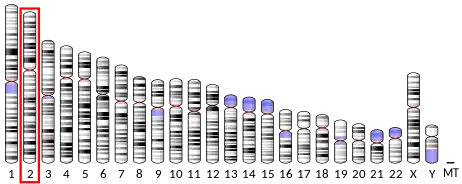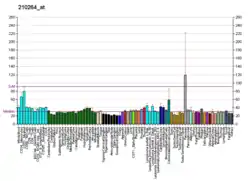G protein-coupled receptor 35 also known as GPR35 is a G protein-coupled receptor which in humans is encoded by the GPR35 gene.[5] Heightened expression of GPR35 is found in immune and gastrointestinal tissues, including the crypts of Lieberkühn.
Ligands
Endogenous ligands
Although GPR35 is still considered an orphan receptor, there have been attempts to deorphanize it by identifying endogenous molecules that can activate the receptor. All of the currently proposed ligands are either unselective towards GPR35, or they lack high potency, a characteristic feature of natural ligands.[6] The following list includes the most prominent examples:
Synthetic agonists
Other synthetic agonists of GPR35 include:
Zaprinast is currently the gold standard in the biochemical evaluation of novel synthetic GPR35 agonists, because it remains potent in an animal model. Most other known agonists display high selectivity towards the human GPR35 orthologue. This phenomenon is well established for other GPCRs and complicates the development of pharmaceutical drugs.[6][14][15]
Antagonists
Antagonists of GPR35 include:
Both ML145 and ML144 unfurl their antagonistic activity through inverse agonism. They are, however, highly species-selective, and practically inactive at the rodent receptor orthologues.[17]
Clinical significance
Deletion of GPR35 gene may be responsible for brachydactyly mental retardation syndrome and is mutated in 2q37 monosomy and 2q37 deletion syndrome.[18] In one study GPR35 has been recognised as a potential oncogene in stomach cancer.[19]
References
- 1 2 3 GRCh38: Ensembl release 89: ENSG00000178623 - Ensembl, May 2017
- 1 2 3 GRCm38: Ensembl release 89: ENSMUSG00000026271 - Ensembl, May 2017
- ↑ "Human PubMed Reference:". National Center for Biotechnology Information, U.S. National Library of Medicine.
- ↑ "Mouse PubMed Reference:". National Center for Biotechnology Information, U.S. National Library of Medicine.
- ↑ O'Dowd BF, Nguyen T, Marchese A, Cheng R, Lynch KR, Heng HH, Kolakowski LF, George SR (1998). "Discovery of three novel G-protein-coupled receptor genes". Genomics. 47 (2): 310–3. doi:10.1006/geno.1998.5095. PMID 9479505.
- 1 2 Divorty, Nina; Mackenzie, Amanda E.; Nicklin, Stuart A.; Milligan, Graeme (2015-03-10). "G protein-coupled receptor 35: an emerging target in inflammatory and cardiovascular disease". Frontiers in Pharmacology. Frontiers Media SA. 6: 41. doi:10.3389/fphar.2015.00041. ISSN 1663-9812. PMC 4354270. PMID 25805994.
- 1 2 3 4 Zhao, P.; Sharir, H.; Kapur, A.; Cowan, A.; Geller, E. B.; Adler, M. W.; Seltzman, H. H.; Reggio, P. H.; Heynen-Genel, S.; Sauer, M.; Chung, T. D. Y.; Bai, Y.; Chen, W.; Caron, M. G.; Barak, L. S.; Abood, M. E. (2010-07-22). "Targeting of the Orphan Receptor GPR35 by Pamoic Acid: A Potent Activator of Extracellular Signal-Regulated Kinase and -Arrestin2 with Antinociceptive Activity". Molecular Pharmacology. American Society for Pharmacology & Experimental Therapeutics (ASPET). 78 (4): 560–568. doi:10.1124/mol.110.066746. ISSN 0026-895X. PMC 2981393. PMID 20826425.
- ↑ Wang J, Simonavicius N, Wu X, Swaminath G, Reagan J, Tian H, Ling L (2006). "Kynurenic acid as a ligand for orphan G protein-coupled receptor GPR35". J. Biol. Chem. 281 (31): 22021–8. doi:10.1074/jbc.M603503200. PMID 16754668.free fulltext Archived 2009-02-17 at the Wayback Machine
- ↑ Southern, Craig; Cook, Jennifer M.; Neetoo-Isseljee, Zaynab; Taylor, Debra L.; Kettleborough, Catherine A.; Merritt, Andy; Bassoni, Daniel L.; Raab, William J.; Quinn, Elizabeth; Wehrman, Tom S.; Davenport, Anthony P.; Brown, Andrew J.; Green, Andrew; Wigglesworth, Mark J.; Rees, Steve (2013). "Screening β-Arrestin Recruitment for the Identification of Natural Ligands for Orphan G-Protein–Coupled Receptors". Journal of Biomolecular Screening. SAGE Publications. 18 (5): 599–609. doi:10.1177/1087057113475480. ISSN 1087-0571. PMID 23396314.
- 1 2 3 Deng, Huayun; Hu, Haibei; Fang, Ye (2012-04-20). "Multiple tyrosine metabolites are GPR35 agonists". Scientific Reports. Springer Nature. 2 (1): 373. Bibcode:2012NatSR...2E.373D. doi:10.1038/srep00373. ISSN 2045-2322. PMC 3330681. PMID 22523636.
- 1 2 Yang, Yuhua; Lu, Jenny Ying-Lin; Wu, Xiaosu; Summer, Shamin; Whoriskey, John; Saris, Christiaan; Reagan, Jeff D. (2010). "G-Protein-Coupled Receptor 35 Is a Target of the Asthma Drugs Cromolyn Disodium and Nedocromil Sodium". Pharmacology. S. Karger AG. 86 (1): 1–5. doi:10.1159/000314164. ISSN 1423-0313. PMID 20559017. S2CID 9421354.
- ↑ Taniguchi Y, Tonai-Kachi H, Shinjo K (2006). "Zaprinast, a well-known cyclic guanosine monophosphate-specific phosphodiesterase inhibitor, is an agonist for GPR35". FEBS Lett. 580 (21): 5003–8. doi:10.1016/j.febslet.2006.08.015. PMID 16934253. S2CID 43142927.
- 1 2 MacKenzie, AE; Caltabiano, G; Kent, TC; Jenkins, L; McCallum, JE; Hudson, BD; Nicklin, SA; Fawcett, L; Markwick, R; Charlton, SJ; Milligan, G (2014). "The antiallergic mast cell stabilizers lodoxamide and bufrolin as the first high and equipotent agonists of human and rat GPR35". Molecular Pharmacology. 85 (1): 91–104. doi:10.1124/mol.113.089482. ISSN 0026-895X. PMC 3868900. PMID 24113750.
- ↑ Thimm, Dominik; Knospe, Melanie; Abdelrahman, Aliaa; Moutinho, Miguel; Alsdorf, Bernt B. A.; von Kügelgen, Ivar; Schiedel, Anke C.; Müller, Christa E. (2013-04-23). "Characterization of new G protein-coupled adenine receptors in mouse and hamster". Purinergic Signalling. Springer Nature. 9 (3): 415–426. doi:10.1007/s11302-013-9360-9. ISSN 1573-9538. PMC 3757137. PMID 23608776.
- ↑ Gütschow, Michael; Schlenk, Miriam; Gäb, Jürgen; Paskaleva, Minka; Alnouri, Mohamad Wessam; Scolari, Silvia; Iqbal, Jamshed; Müller, Christa E. (2012-04-12). "Benzothiazinones: A Novel Class of Adenosine Receptor Antagonists Structurally Unrelated to Xanthine and Adenine Derivatives". Journal of Medicinal Chemistry. American Chemical Society (ACS). 55 (7): 3331–3341. doi:10.1021/jm300029s. ISSN 0022-2623. PMID 22409573.
- 1 2 Susanne Heynen-Genel; Russell Dahl; Shenghua Shi; Michelle Sauer; Santosh Hariharan; Eduard Sergienko; Shakeela Dad; Thomas DY Chung; Derek Stonich; Ying Su; Marc Caron; Pingwei Zhao; Mary E Abood; Lawrence S Barak (2010). "Selective GPR35 Antagonists - Probes 1 & 2". National Center for Biotechnology Information (US). PMID 21433393. Bookshelf ID NBK50703.
{{cite journal}}: Cite journal requires|journal=(help) - ↑ Jenkins, L.; Harries, N.; Lappin, J. E.; MacKenzie, A. E.; Neetoo-Isseljee, Z.; Southern, C.; McIver, E. G.; Nicklin, S. A.; Taylor, D. L.; Milligan, G. (2012-09-11). "Antagonists of GPR35 Display High Species Ortholog Selectivity and Varying Modes of Action". The Journal of Pharmacology and Experimental Therapeutics. American Society for Pharmacology & Experimental Therapeutics (ASPET). 343 (3): 683–695. doi:10.1124/jpet.112.198945. ISSN 1521-0103. PMC 3500541. PMID 22967846.
- ↑ Shrimpton AE, Braddock BR, Thomson LL, Stein CK, Hoo JJ (2004). "Molecular delineation of deletions on 2q37.3 in three cases with an Albright hereditary osteodystrophy-like phenotype". Clin. Genet. 66 (6): 537–44. doi:10.1111/j.1399-0004.2004.00363.x. PMID 15521982. S2CID 42975740.
- ↑ Okumura S, Baba H, Kumada T, Nanmoku K, Nakajima H, Nakane Y, Hioki K, Ikenaka K (2004). "Cloning of a G-protein-coupled receptor that shows an activity to transform NIH3T3 cells and is expressed in gastric cancer cells". Cancer Sci. 95 (2): 131–5. doi:10.1111/j.1349-7006.2004.tb03193.x. PMID 14965362. S2CID 22753833.




